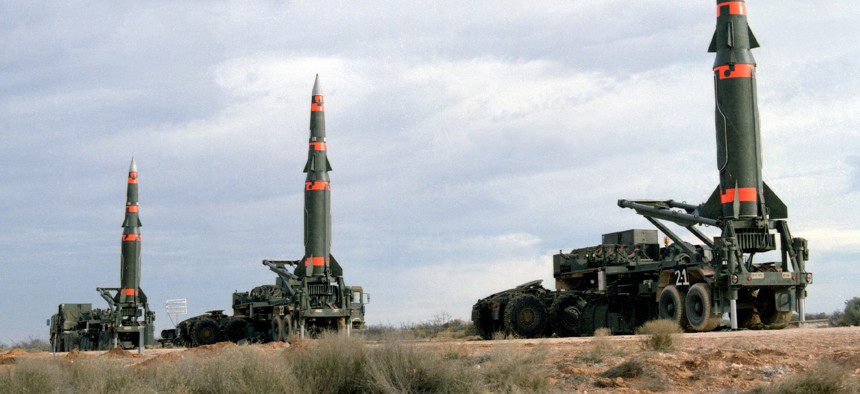
Several U.S. Pershing II intermediate-range ballistic missiles are prepared for launching at Fort Bliss's McGregor Range in New Mexico in December 1987. Defense Department / Frank Trevino
Save This One Piece of the INF Treaty
Preserving the ballistic-missile ban would reduce the danger of leaving the treaty — and light a path to its replacement.
Taken off life support in February by the Trump administration’s suspension of compliance, the Intermediate-Range Nuclear Forces Treaty will be officially declared dead on Aug. 2. We must now urgently consider how to keep alive one part of the agreement — the ban on intermediate-range ballistic missiles — until a new INF arms control treaty can be born.
When the Treaty was first being negotiated, such missiles were causing the most concern in Moscow and Washington, as these nuclear-armed, first-strike weapons had not been captured by the limits on strategic systems in the SALT I and SALT II Treaties. In 1979, NATO decided to respond to burgeoning Soviet deployments of the SS-20, a new triple-warhead ballistic missile with a range of 5,000 kilometers. The alliance pledged to deploy U.S. ballistic and cruise missiles to five member countries in Europe, while simultaneously seeking equal limits between the sides in order to remove the Soviet advantage.
The Soviets were determined to prevent deployment of new U.S. missiles, especially 108 highly accurate Pershing II medium-range ballistic missiles destined for West Germany, which the Kremlin regarded as a short-warning threat to Soviet command-and-control centers around Moscow. When they failed to prevent deployments through political pressure, the Soviets ultimately accepted an agreement to eliminate all ground-based INF missiles on both sides.
If ballistic missiles helped birth the INF Treaty, the issues most responsible for its death revolved around cruise missiles — specifically, the actual range of Russia’s 9M729 land-attack cruise missile and the potential capability of the U.S. Aegis Ashore Mark-41 missile defense launcher to launch INF-range, land-attack cruise missiles. Beginning in 2014, both sides exchanged public accusations; senior U.S. officials, in particular, complained to Russian counterparts about the damage Russia’s violation was doing to the INF Treaty. Unfortunately, neither side chose to fully exploit the treaty’s mechanism for resolving such compliance disputes.
Related: Two Ideas That Might Stop a Post-INF Arms Race, and One That Won’t
Related: The INF Treaty Is Doomed. We Need a New Arms-Control Framework
Related: Poll: Americans Want To Stay In Nuclear Arms Control Agreements
Then the Trump administration began to argue that staying in the treaty was dangerous because the agreement did not include limitations on Chinese INF-range systems — a stance that undermined its previous argument that Russia’s non-compliance was forcing Washington to consider withdrawing. Suspicions grew that the Russian violation was “an excuse” to leave rather than “the reason,” particularly since there had been no serious diplomatic efforts to engage China in INF arms control.
Regardless of which country was more responsible for the failure to resolve compliance issues around cruise missiles—or whether immediate inclusion of China in the INF Treaty is at all feasible—there is now a more urgent matter. Both parties must figure out how to retain the current ban on INF-range ballistic missiles. The ban is crucial to European security and for maintaining stability between the countries possessing more than 90 percent of the world’s nuclear arsenals.
On the U.S. side, the first step will be up to Congress, as the executive branch is moving briskly toward a post-INF-treaty world. The same day that the Trump administration formally provided the required six months’ notice of withdrawal from the treaty, it suspended its own compliance, discouraging any last-minute attempts to save the treaty. With a green light from U.S. policy-makers, the military and defense industries quickly developed plans for at least two new, land-based ballistic missiles of INF-range. One of them, an IRBM with a range of 3,000 to 4,000 km, is already slated for a test flight in November and deployment in five years. (There was no security threat requiring the Pentagon to conduct non-treaty-compliant military testing and no previous deployment timetable that had to be met.) And the Army is pursuing several other ballistic missile systems with INF ranges.
Meanwhile, Russian President Putin has pledged to “mirror” any U.S. violations, although the Russians have implied that their initial response would be land-based deployments of the shipborne SM-54 Kalibr cruise missile.
Once either side flight-tests or deploys previously banned ballistic missiles, it will become much more difficult to prevent a full unraveling of INF arms control constraints. The Democratically-controlled House of Representatives must put a hold on funds going toward all such systems until the administration devises a coherent policy toward negotiating a substitute for the INF Treaty.
In its most practical form, an INF ballistic missile ban could simply require a pollical commitment from the treaty’s five parties — the United States, Russia, Belarus, Ukraine, and Kazakhstan — that they would take no action inconsistent with the ban on the development and deployment of INF-range ballistic missiles. The parties have so far abstained from INF-range ballistic missile development and deployment. Continuing to do so would limit damage and build trust, facilitating the negotiation of a new framework for INF arms control.
In an upcoming publication of the U.S.-German-Russian Deep Cuts Commission of which I am a member, non-governmental arms control experts have articulated three ambitious options for future INF arms control, including proposed bans on:
* Nuclear-armed ground-based cruise missiles and drones.
* Nuclear-armed sea- and air-based non-strategic missiles.
* Arming any non-strategic delivery vehicle with nuclear gravity bombs.
Pursuing any of these options would take time and would require a stronger demonstration of will and determination than we have seen from the current leaders in Washington and Moscow. But taking immediate action to preserve the INF Treaty’s ballistic missile ban is a good first step.




